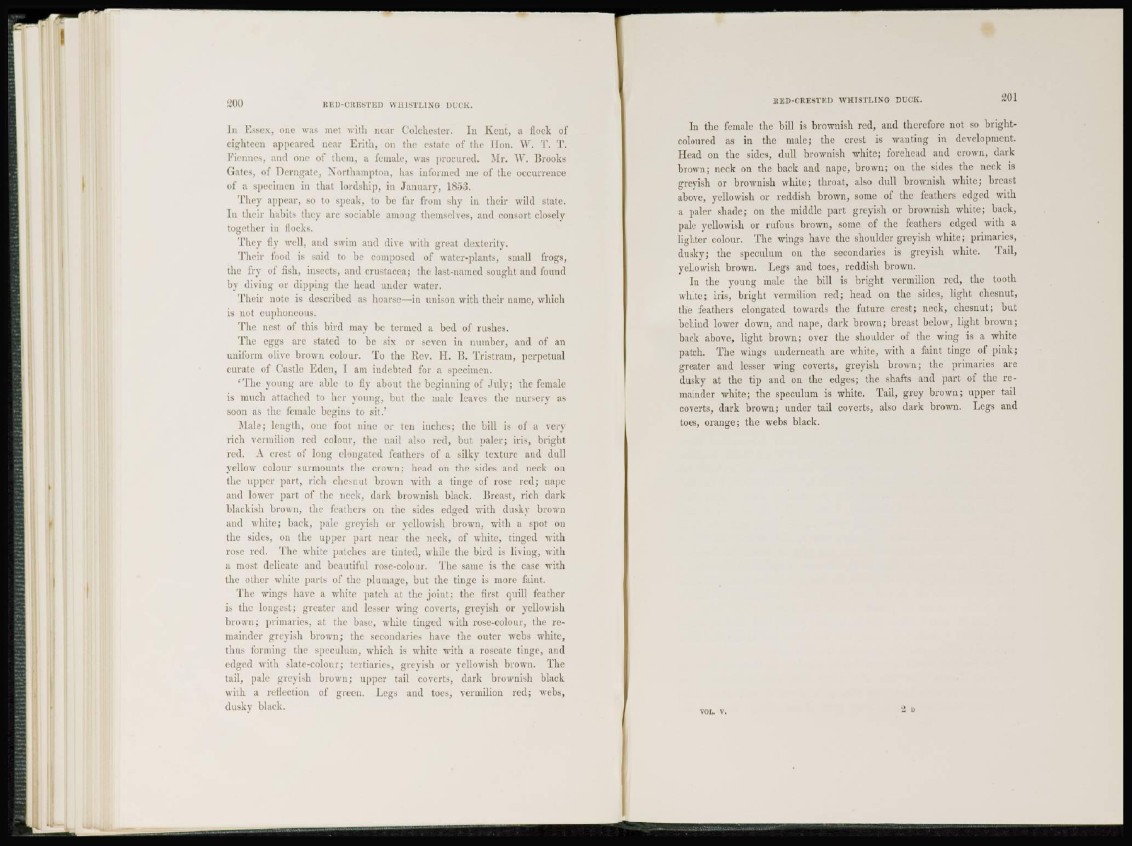
goo RED-CRESTED WHISTLING DUCK.
In Essex, one was met with near Colchester. In Kent, a flock of
eighteen appeared near Erith, on the estate of the Hon. W. T. T.
Fiennes, and one of them, a female, was procured. Mr. W. Brooks
Gates, of Derngate. Northampton, has informed me of the occurrence
of a specimen in that lordship, in January, 1853.
They appear, so to speak, to he far from shy in their wild state.
I n their habits they are sociable among themselves, and consort closely
together in flocks.
They fly well, and swim and dive with great dexterity.
Their food is said to be composed of water-plants, small frogs,
the fry of fish, insects, and Crustacea; the last-named sought and found
by diving or dipping the head under water.
Their note is described as hoarse—in unison with their name, which
is not euphoneous.
The nest of this bird may be termed a bed of rushes.
The eggs arc stated to be six or seven in number, and of an
uniform olive brown colour. To the Kev. H. B. Tristram, perpetual
curate of Castle Eden, I am indebted for a s]3ccimcn.
' T h e young are able to fly about the beginning of July; the female
is much attached to her young, but the male leaves the nursery as
soon as the female begins to sit.'
Male; length, one foot nine or ten inches; the bill is of a very
rich vermilion red colour, the nail also red, but paler; iris, bright
red. A crest of long elongated feathers of a silky texture and dull
yellow colour surmounts the crown; head on the sides and neck on
the upper part, rich chesuut brown with a tinge of rose red; nape
and lower part of the neck, dark brownish black. Breast, rich dark
blackish brown, the feathers on the sides edged with dusky brown
and white; back, pale grej ish or yellowish brown, with a spot on
the sides, on the upper part near the neck, of white, tinged with
rose red. The white patches are tinted, while the bird is living, with
a most delicate and beautiful rose-colour. The same is the case with
the other white parts of the plumage, but the tinge is more faint.
The wings have a white patch at the joint; the first quill feather
is the longest; greater and lesser wing coverts, greyish or yellowish
brown; primaries, at the base, white tinged with rose-colour, the remainder
greyish brown; the secondaries have the outer webs white,
thus forming the speculum, which is white with a roseate tinge, and
edged with slate-colour; tertiaries, greyish or yellowish brown. The
tail, pale greyish brown; upper tail coverts, dark brownish black
with a reflection of green. Legs and toes, vermilion red; webs,
dusky black.
It E D - C R E S T Kl) W H I S T L I N G DUCK. 201
In the female the bill is brownish red, and therefore not so brightcoloured
as in the male; the crest is wanting in development.
Head on the sides, dull brownish white; forehead and crown, dark
brown; neck on the back and nape, brown; on the sides the neck is
greyish or brownish white; throat, also didl brownish white; breast
above, yellowish or reddish brown, some of the feathers edged with
a paler shade; on the middle part greyish or brownish white; back,
pale yellowish or rufous brown, some of the feathers edged with a
lighter colour. The wings have the shoulder greyish white; primaries,
dusky; the speculum on the secondaries is greyish white. 'Jail,
yellowish brown. Eegs and toes, reddish brown.
I n the young male the bill is bright vermilion red, the tooth
white; iris, bright vermilion red; head on the sides, light chesnut,
the feathers elongated towards the future crest; neck, chesnut; but
behind lower down, and nape, dark brown; breast below, light brown;
back above, light brown; over the shoulder of the wing is a white
patch. The wings underneath are white, with a faint tinge of pink;
greater and lesser wing coverts, greyish brown; the primaries are
dusky at the tip and on the edges; the shafts and part of the remainder
white; the speculum is white. Tail, grey brown; upper tail
coverts, dark brown; under tail coverts, also dark brown. Legs and
toes, orange; the webs black.